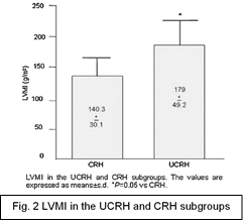Uncontrolled resistant hypertension (UC-RHTN) is defined as a blood pressure (BP) that remains above the desired level (140/90 mmHg) in spite of the concurrent use of three or more antihypertensive agents of different classes. Controlled resistant hypertension (C-RHTN) is defined as a blood pressure (BP) is controlled using four or more antihypertensive medications. Yugar-Toledo JC et al., conducted a study which reviewed the issue dividing resistant hypertension as controlled (C-RHTN) and uncontrolled (UC-RHTN) resistant hypertension with refractory hypertension (RfHTN), an extreme phenotype of uncontrolled hypertension (taking 5 or more antihypertensive drugs) being included in the latter subgroup (UC-RHTN). Some characteristics of isolated RfHTN are highlighted below.
Clinical Differences
- 133 consecutive patients were included in a study for RHTN treatment
- All the individuals had a complete case report and underwent a physical examination, electrocardiography, and laboratory tests to eliminate secondary forms of hypertension
- 90 individuals were classified as RHTN patients after a 6-month period (five to six visits)
- They were divided into two subgroups were uncontrolled (UC-RHTN; n = 47) and controlled (CRHTN; n = 43) RHTN patients and plasma aldosterone concentration (PAC)
- UC-RHTN patients showed higher body mass index (BMI), vascular stiffness, plasma aldosterone levels, and left ventricle hypertrophy (LVH) as compared to C-RHTN (Fig. 2)
- PWV was appeared to be dependent on age in both UC-RHTN and C-RHTN patients in multivariate analysis, although the influence of aging was more important in the UC-RHTN (Fig. 3)
- UC-RHTN patients had higher carotid intima-media thickness (IMT) and PWV, reflecting thicker and stiffer arteries after one year
- PWV was significantly dependent on age in RHTN patients in multivariate linear regression (β = 0.005; s.e. = 0.001; p < 0.05). UCRHTN patients had stiffer arteries and higher left ventricular mass index in all age strata.
“UC-RHTN and C-RHTN are not in the same bag.” Both C-RHTN and UC-RHTN are extreme phenotypes of hard-to-control BP but some mechanisms of the disease and clinical expressions are distinct.




